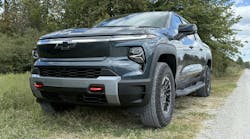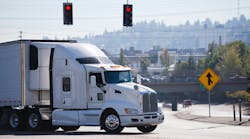One thing that fascinated me is drivers who achieve high miles per gallon on a regular basis. The national average mile per gallon is 6.91, and fleets in NACFE’s most recent Fleet Fuel Study have an average mile per gallon of 7.7, but there are drivers who are regularly doing better than that.
We were fortunate enough to have some of those fleets and drivers in the recently completed Run on Less – Messy Middle. Here are some interesting statistics from the Run. Two of the diesel trucks traveled 22,550 miles during the 18 days of the Run and averaged 11.6 mpg. And one truck that was running on 99% biodiesel traveled 5,418 miles and achieved 9.5 mpg.
That kind of mileage per gallon doesn't happen by accident. Of course, the way a truck is spec’d plays a big role in its fuel economy, but even the most aerodynamic truck is not going to achieve double-digit mpg if it is not driven properly. Drivers who operate their vehicles with fuel efficiency in mind realize that going fast is not necessarily a best practice. Sometimes it makes sense to slow down. I am not talking about creeping along the highway but rather dropping the speed by 5 mph, e.g., from 68 to 63. Obviously, this can’t be done if it means missing a delivery window, but in many instances, slowing down will not impact delivery deadlines.
Dispatchers and drivers should also look at routing to see if drivers can avoid congested areas during peak travel times. Sitting in stop-and-go traffic is bad for fuel economy. I am not suggesting that trucks accumulate extra miles to avoid congestion, but perhaps if drivers change the time at which they leave the depot, they may be able to avoid some of the worst congestion.
Highly fuel-efficient drivers also pay close attention to their following distances. They do this for a variety of reasons, one of which is to avoid having to brake frequently. It takes a lot of fuel to get back up to speed after a stop, so savvy drivers do what they can to mitigate unnecessary stops.
Doing all these things can lead to a 3% to 5% improvement in miles per gallon. And while that might not sound like a lot, it can mean thousands or even tens of thousands of dollars in fuel savings.
Listen to what drivers with high miles per gallon told us during our site visit interviews for Run on Less – Messy Middle if you don't believe me.
Henry Albert, president of Albert Transport, says he focuses keenly on fuel mileage for two reasons. “One, it's just the right thing to do. It's good for the environment. It's good for the world. The other is my number one expense as an owner-operator is my fuel bill.” He says the way he maximizes his efficiency is by making decisions on a daily basis that he sometimes changes on an hourly basis as he responds to conditions.
Roberto Sandoval, a driver for Mesilla Valley Transportation who is also a driver trainer, says he teaches drivers “to drive 55 mph first. And I tell them to be patient and not to follow too close.”
I suggest you adopt some of these driving tips and see what happens to your fuel economy numbers. I’d love to hear the results of your efforts, which I will gladly share to help improve the national average fuel economy.



